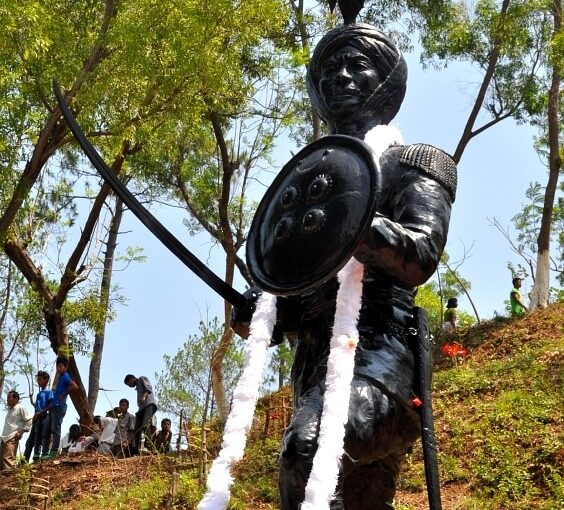The establishment of European colonizers is the starting of India’s Modern History. The period from the 15th century to the 20th century of Indian history is full of heroic resistance put up by the native Indians to stop the advancement of these European powers.
These Europeans especially the East Indian Company of the British Empire initially presented themselves as traders and merchants to hide their evil motives of subjugating the vast wealth and resources of India. The British stealthily started their expansion in India and with the primary aim of capturing the rich and fertile region of Bengal.
The major event which marked the rule of EIC in India was the battle of Buxar (in 1765 CE). It was after this battle the British were given the administrative and financial rights to control Bengal. Swiftly after it, the British started to exploit the peasants through their draconian laws and tax policies.
Kingdom after kingdom joined the suzerainty of this alien rule and those who refused were slaughtered in cold blood. While the expansion of the British Raj in India is well known but one fact that is missing or erased is the anecdotes of those heroes of this country who refused to surrender in front of the British Raj and put up a valiant resistance to protect their motherland.
When we talk about the personalities who led an armed insurrection against the British the first incident that strikes our mind is the sepoy mutiny of 1857. Some revolutionaries also put up gallant resistance against the British Raj but these names are very few and we stuck in an unending cycle of finding the names of those who lay down their lives to free their country from alien rule.
As a citizen of this county whether from North, South, East of West we all are familiar with the names of Lakshmi Bai, Bhagat Singh, Netaji, Chandrashekhar Azad, etc who fought against the British Raj for the freedom of this country.
But what about North-East India? Was there any freedom fighter? Or should we say that just like we had ignored our northeastern states and their people whether from our country’s map or from our society we had ignored those freedom fighters too who hailed from the northeast?
The names of Rani Gaidinliu, U Tirot Sing, and many more had been completely wiped out from textbooks. In this article, we will cover the story of Manipur General and his army of 300 men who declare war against the British in 1891.
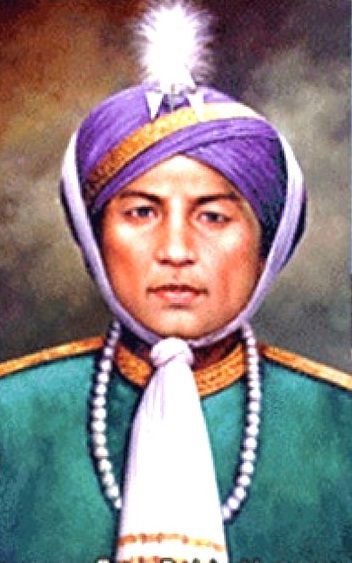
The Hero of Anglo Manipur War(Battle of Khongjom). Before the battle of Khongjom, he was commissioned as the Subedar in the Manipur Army.
The name of his forgotten freedom fighter is Major Paona Brajabashi.
Content
Background: Early History of Manipur
From ancient times the land of Manipur is the home of the Meitei people. It is believed that from the 1st century BCE these people are living on these terrains having the ethnicity of East Asian and Indo-European.
Note: Manipuri text Cheitharol Kumbaba speaks of the 9 different clans of the Meitei, which later merged into 7.
King Loiyumba is the founder of the Meitei kingdom who is believed to have founded it around the 12th century CE. Furthermore, in the 15th century, these Meitei tribes came in contact with the Burma tribes and this led to marriage alliances between the two.
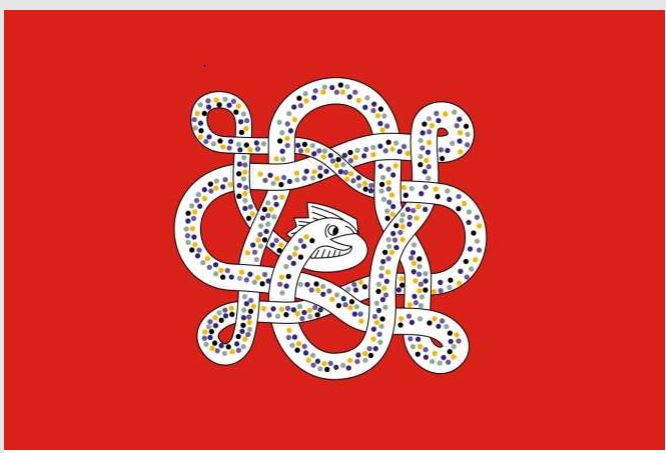
In the year 1714, the King of Manipur Meidingu Pamheiba adopted Hinduism and even declared it as the state religion and changed his own name to Gharib Nawaz.
Note: 1724 – The Sanskrit name “Manipur” (abode of jewels) was adopted as the name of the state.
At this time the relation between the Burmese Empire and the Meitei became bitter and several conflicts took place between them. After the death of Gharib Nawaz, the Konbaug Burmese Empire invaded Manipur.
Due to this Meitei king Jai Singh (ChingThang Khomba) decided to take help from the East India Company to drive back the invaders. A treaty was signed between EIC and the Manipur king to drive the Burmese away.
Note: EIC troops later withdrawn, leaving Manipur to defend itself on its own.
These incursions from the Burmese continued later in the 19th century and in the year 1824 Gambhir Singh (Chinglen Nongdrenkhomba) again asked EIC for help against the Burmese. This led to the Anglo Burmese War from 1824-1826 which ended in the Treaty of Yadambo and the establishment of Manipur as an independent state.
Colonial Era
Gambhir Singh signed the subsidiary alliance and accepted British suzerainty. Due to this EIC established its foothold in Manipur politics. But after the death of King Gambhir, there was political chaos in the Manipur Kingdom and for more than 50 years, this political struggle continued.
The British were closely observing these incidents and in 1835 they established British residency in Imphal to facilitate communication between the British and the rulers of Manipur. The influence of the British became out of control and due to this, a leader emerged in Manipur politics to stop the influence of the British. His name was Senapati Tikendrajit.
The British looked towards Tikendrajit as a threat to their plan and they took every step to stop him. With the death of Maharajah Chandrakirti in 1886, there was a struggle for the throne of the Manipur. Maharaja Surchandra then ascended the throne but he was a weak and ineffective ruler who had sided with the British.
Due to this Crown prince, Kulachandra, and the Senapati i.e. Tikendrajit revolted against King Surchandra. Due to this Maharaja Surchandra appealed to the British Viceroy (Lord Lansdowne) for help.
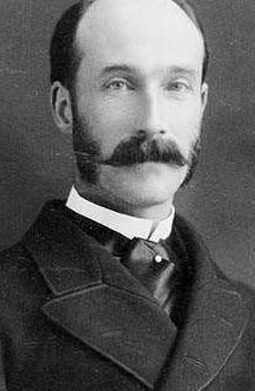
In return, Lord Lansdowne sent JW Quinton the Chief Commissioner of Assam with 400 soldiers under Colonel skene to capture Tikendrajit. Quinton arrived in Manipur in 1891 with 400 force Gurkha soldiers. Their main aim was to capture the Senapati and declare Kulachandra as the king of Manipur.
The British organized a darbar in which king Kulachandra came but Tikendrajit didn’t. Due to this, the British declare war against the Manipur kingdom. On 22 March 1891, the British attacked Kangla. But this plan of the British backfired and 5 commanders were killed along with JW Quinton. However heavy casualties were inflicted on the Manipuri soldiers who were fighting with traditional weapons.
This enraged the British army and on 31 March 1891, the British sent 3 huge forces to attack Manipur. These forces were under the command of Major General H.Collet, Colonel RHF Rennick, and Brigadier General T.Graham.

When the British captured Toubal village the outnumbered Manipur soldiers decided to retreat. But on 1 April around 2000 Manipur Soldiers laid siege to the village. But the siege was lifted by the reinforcements of the British army. On 23 April the British killed Poila Meiraba.
Battle of Khongjom: Paona Brajabashi and his 400 Men
This was the final battle of the Anglo Manipur war which was fought on 25th April 1891. This battle was fought on the southern part of Manipur between the forces of Brigadier General T Graham and the forces of Paona Brajabashi.
The enemy’s shell can land in our camp whereas ours cannot in theirs. My fellow countrymen! It is a disgrace to die fleeing. Death is now certain for us. But we will never retreat:
……………..Paona Brajabashi
Paona Brajabashi and his 400 men reached Thoubal located on the western side of the Khongjom River. The British in return captured Pallel, and Kakching. On 23 April the British used their heavy artillery to destroy the Manipuri camps.
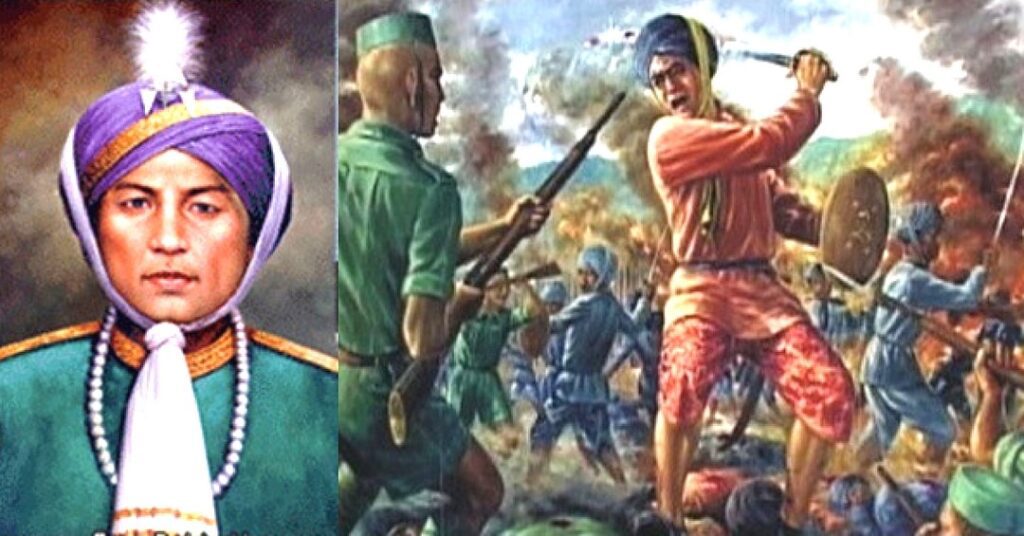
Battle of Khongjom (Third battle of the Anglo Manipur War)
After this artillery attack, the British army moved to Khongjom hill. This was the place where the 400 Manipuri soldiers showed their valor and indomitable courage.
The Manipur forces under Paona Brajabashi and Chongtha Mia attacked the British forces and killed many of them. The British witnessed stiff resistance despite being superior to the Manipuri men and ammunition.
One by one Manipuri soldier attained martyrdom and it is believed that Paona Brajabashi kept fighting despite being badly wounded.
At that time almost all of the Manipuri soldiers had attained martyrdom and only Paona Brajabashi continued fighting. Seeing the bravery of Major Paona Brigadier General T.Graham offered him to join the British army or chose death if he refused.
But Paona Brajabashi said refused and attained martyrdom there. Soon after this Manipur was captured by the British and the flag of Union Jack was hoisted on Kangla Palace.
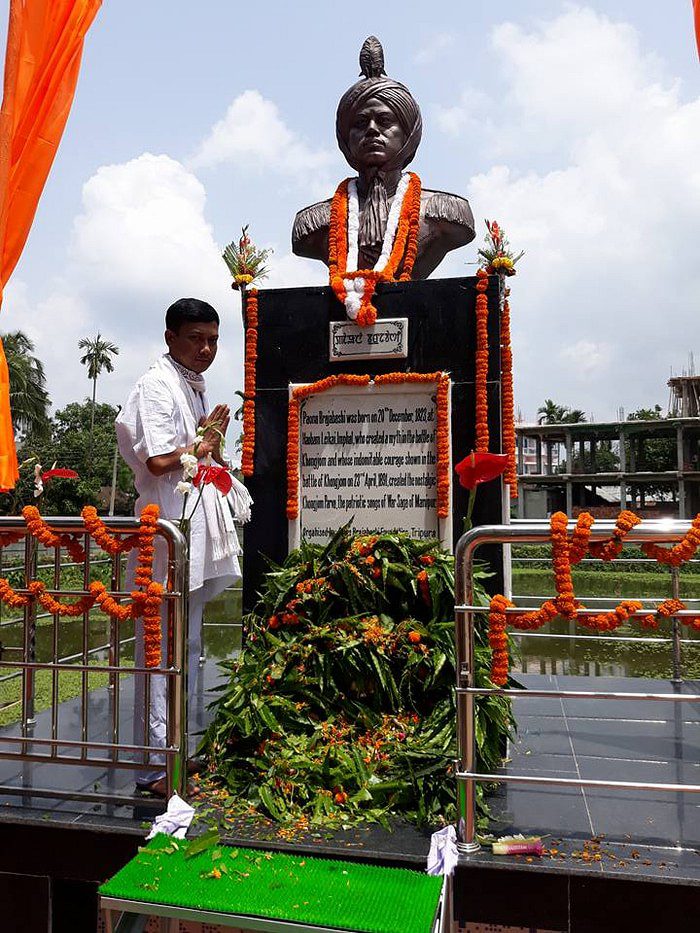
Today, 13th August is commemorated as “Patriots Day” by the people of Manipur. While the northeastern people suffer from the acts of Racism it is our duty to tell the young generations to know more about the Heroes of North East India who lay down their lives for this country.
LIKE WHAT WE ARE DOING? DONATE TO DHARMAYUDH !
If you Support what we are doing and would like to contribute to help us grow and reach more Indians to teach them more about such forgotten historic Indian Heroes and stories, please consider donating any amount. It will help us grow.

